The parrot world is awash with colors having every variety of hue in its bucket. But nothing evokes a timeless charm quite like the color black.
Black parrots are not as common as the more vibrantly colored ones, but they are just as beautiful and enchanting.
The color black brings a range to their appearance as some look regal and majestic, while others exude an enigma or even an intimidating aura.
In this feature, we are going to cover the different black parrot species around the world and talk about their habitat, color differences, and what makes them unique.
Quick Navigation
Types Of Black Parrots
Below are the 11 black parrot species:
Dracula Parrot
Also known as Pesquet’s parrot, the Dracula parrot is a large and bulky bird native to the rainforests of New Guinea. In addition to the scary name, it has a menacing look as well.
The male Dracula Parrot has a bare face with black plumage, featuring a distinctive red mark behind the eye. The breast to upper abdomen displays brown and black feathers with scalloped grey patterns, while the lower underparts and underwing coverts are striking red. The female looks almost the same with the exception of the red mark behind the eye.
It has loud screechy calls that have been described as rasping growls. Despite their vulturine look, these parrots are frugivores. They feed on fruits, particularly figs, as well as flowers and nectars.

Palm Cockatoo
Also known as the great black cockatoo, the Palm cockatoo is a parrot native to the rainforests and savannas of New Guinea, and the Cape York Peninsula in Australia. Its plumage is entirely black or smokey grey. adorned with a large, exposed red patch of skin under its eyes.
Their cheeks flush and change color when they experience excitement or stress, which can be used to gauge their mood. When stressed, the cheeks turn pinkish, whereas, during excitement, they can appear dark pink, scarlet, or orange. Palm cockatoos also possess a sizable crest on its head, which is another tool of non-verbal communication for these parrots.
They are gentle and social birds, but they are not as easy to handle as other parrots. These birds are considerably large with powerful beaks, which makes them unsuitable for family settings and children.
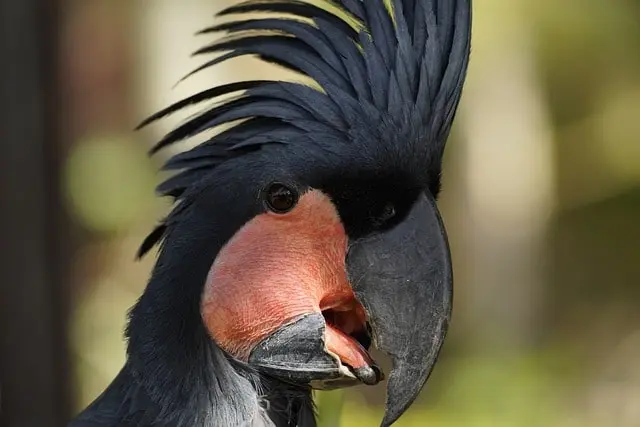
Seychelles Black Parrot
The Seychelles Black Parrot is an endemic parrot species mainly found on the Praslin islands of Seychelles in the western Indian Ocean. They appear to be black but their actual color is brown-grey.
The primary food sources for the Seychelles black parrots are the Verschaffeltia splendida, an endemic palm, and the introduced Averrhoabilimbi.
The breeding period for the Seychelles Black Parrot occurs between October and February. However, there is limited availability of suitable nesting sites, such as the standing rotting trees of Pandanus, Lodoicea, and Albizia, which is a potential reason for their population decline.
Black Lory
The Black Lory also known as the Rajah Lory is a medium-sized parrot native to West Papua in Indonesia. Unlike most parrots in its genus, known for their outstanding colors, the black lory features an almost monotone plumage.
The black lory is glossy black, with a violet or blue rump, and a red and yellow undertail. The juveniles have a white ring around their eyes, which is a useful way to distinguish them from the adults.
Interestingly, the black lory is found to have three subspecies, which also have deep black plumage with slight variations. The subspecies of the black lory include:
Chalcopsitta atra atra: Overall black plumage with violet/blue rump and yellow undertail with red at the bottom.
Chalcopsitta atra bernsteini: Adult males display distinctive red and purple markings on their foreheads and thighs, which are less pronounced in females. They exhibit a darker blue coloration on the rump.
Chalcopsitta atra insignis: Black plumage with stripes of red on the chest, eyes, underwings, and thighs. They also feature a dull rump, with the undertail covers displaying a grey-blue shade.
In their natural habitat, these lories mostly eat a frugivore diet that includes Pollen, Nectar, Flowers, Fruit, and sometimes insects. Although they have garnered much attention due to their stunning appearance, they are still less commonly seen in captivity.
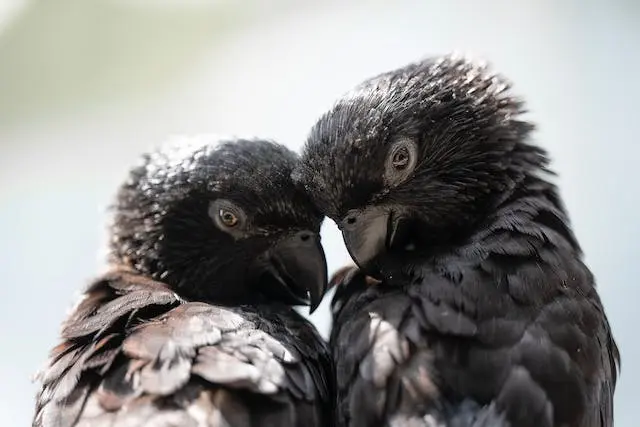
Gang-Gang Cockatoo
The Gang-Gang Cockatoo is a smaller species of cockatoo found in the woodland forests of south-eastern Australia. It does not have an outright black color, but its plumage is dark grey from the neck down. The male gang-gang cockatoo has a scarlet red head and crest, while the female has a gray head and crest.
In the wild, they congregate in large flocks when foraging. They eat a varied diet that includes Eucalypt seeds, nuts, fruits, berries, insects, and insect larvae.
Gang gang cockatoos are an endangered species and hence not commonly seen as pets. They require plenty of attention and care from their owners. Gang Gang cockatoos are decent talkers but they do not have the clarity of voice like other cockatoos.
They make growling and screeching calls and have a raspy voice. These birds have a lifespan of over 60 years, which makes them a long-term commitment.
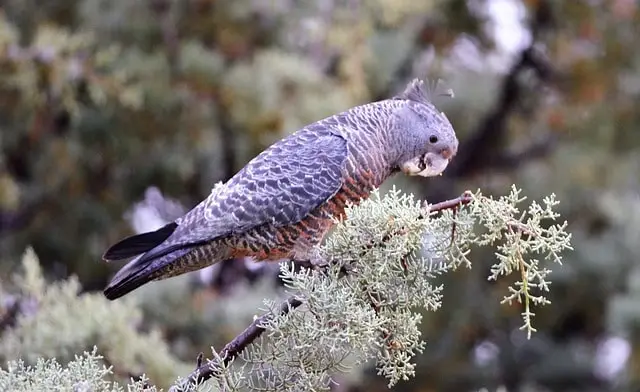
Vasa Parrot
The Vasa Parrot hails from the forests of Madagascar and nearby islands in the western Indian Ocean. Vasa parrots have predominantly greyish-black plumage with pink-colored beaks and white eyerings. The undertail coverts and shafts of feathers display black streaks.
Vasa parrots have an unusual look, but they are incredibly social and affectionate birds that make wonderful family pets. They have the natural inclination to chew the house furniture, which is why they need their toys to keep themselves active.
The vasa parrot is considerably big measuring up to 20 inches with a long neck and tail. They require a roomy enclosure like an aviary to be able to spread their wings and move around.

Glossy Black Cockatoo
Glossy Black-Cockatoos are the smallest of the black cockatoos found in Australia. They have a widespread distribution across Australia and their habitats often overlap with other black cockatoos.
This sometimes makes it difficult for aviculturists to distinguish between them and other black cockatoos, however, experts have found numerous ways around this.
The Glossy Black Cockatoo is a sexually dimorphic species, meaning the males and females have different appearances. The male has a glossy black plumage, a brownish-black head, and red or yellow tail feathers.
On the other hand, the female glossy black cockatoo has a similar black body with yellow patches on their face and underside of the tails.
The Glossy Black-Cockatoos are called she-oak specialists because they feed exclusively on she-oaks. They usually feed in pairs, which is the male and the female, or in a trio, which includes the parent and the young bird. They can sometimes be seen in small flocks, though it is extremely rare to see them in large groups.
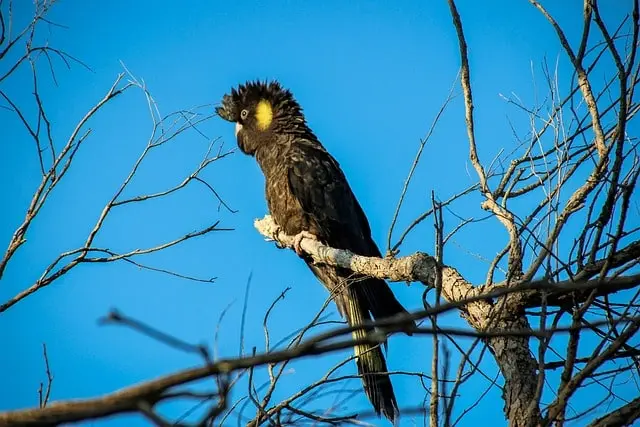
Yellow-Tailed Black Cockatoo
The Yellow-Tailed Black Cockatoo is a captivating bird native to south-eastern Australia. These large cockatoos are predominantly black featuring vibrant yellow markings on their underwings and chest. They also have a yellow cheek patch located slightly behind their ears and yellow tail feathers.
Yellow-Tailed Black Cockatoos are sexually dimorphic, however, it is very hard to tell the difference between them from a distance because the detail is so slight. The male Yellow-Tailed Black Cockatoo has a pink eyering, with which it can be sexed.
These cockatoos can be seen foraging in small to large flocks and their diet mainly consists of seeds of pinecones and native trees as well as fruits from ground plants and some insects.
The Yellow-Tailed Black Cockatoo reaches sexual maturation at around 4 years of age. Their breeding season lasts from November to February and they typically lay a clutch of 2 eggs during one season.
Red-Tailed Black Cockatoo
The Red-tailed Black Cockatoo is another Australian native parrot with a majestic appearance. It is characterized by its impressive size, dark black plumage, bright red undertail, and yellow spots on the face, neck, and wings.
Their diet is primarily composed of seeds, with a preference for seeds of eucalypts, casuarinas, acacias, and banksias. In addition to seeds, they incorporate fruit, berries, nectar, and flowers into their diet. On occasion, they may also consume insects and larvae.
The Red-tailed Black Cockatoo is monogamous by nature and engages in intricate courtship displays to attract a mate. Their breeding season occurs mainly in autumn and spring.

Baudin’s Black Cockatoo
Baudin’s Black-Cockatoos is endemic to south-western Western Australia, particularly between Albany and Perth. Depending on the climate, they may disperse and can be found in different parts of the area in different seasons.
Baudin’s Cockatoos are a brownish-black plumage with white edges on their feathers. They also have a white patch on their ear coverts. Among the black cockatoos of Australia, Baudin’s cockatoos are the least visible. They are less commonly seen flying around or gathering on feeding sites because they are a threatened species.
They forage in forest canopies and consume seeds from the marri tree, though they also have a knack for commercial fruit crops. According to WWF Australia, habitat loss is one of the main causes of the decline in the population of the Baudin’s Black Cockatoo, however, they also face threats from illegal shooting by orchardists who want to protect their crops from being raided by birds.
Carnaby’s Black Cockatoo
The Carnaby’s Black Cockatoo is a beautiful black parrot species that is admired across all of Western Australia for its impressive plumage. It has a rustic greyish-black color with a white cheek patch and tail panels.
These birds have a playful personality and live a social life in large flocks. They are socially monogamous and breed in tree hollows.
Carnaby’s Black Cockatoo is classified as an endangered species that experienced a decline in both range and population in southwestern Australia.
Their population suffered a series of unfortunate events notably between October 2009 and March 2010, when a potential outbreak of disease occurred in one of its main breeding areas, and a severe localized hailstorm struck the region. These events, along with an emerging threat of collisions with motor vehicles of large flocks resulted in a substantial number of fatalities.
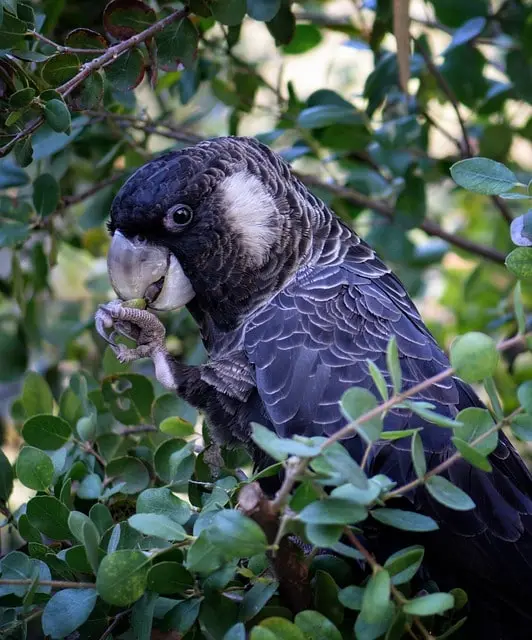
How Do Parrots Produce Black Color In Their Feathers?
Making dark hues such as black is not as complex as the brighter colors that parrots exhibit. Parrots get their feather coloration by pigments and structural arrangement of feathers or a combination of the two.
Parrots produce black color mainly through melanin, which is a type of pigment common across many species. Melanin is found in the cells of both the skin and the feathers of parrots.
This pigment is responsible for producing colors ranging from the darkest black, and grey to light brown, pale yellow, and brownish red. In the case of black feathers, a higher concentration of melanin is generally responsible for the dark hue.







